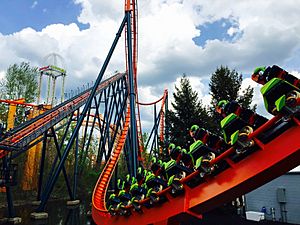Kinetic energy facts for kids

In physics, kinetic energy is the energy an object has because it is moving. Think of it as the energy of motion!
To understand it better, imagine you need to push a toy car to make it move. The effort you put in to make it go from standing still to moving is the "work" done. Once the car is moving, it has kinetic energy. It keeps this energy unless its speed changes. If you want the car to stop, it will do the same amount of "work" as it slows down.
The standard unit for measuring kinetic energy is the joule. In some places, like the United States, people might also use the foot-pound.
Contents
What is Kinetic Energy?
Energy comes in many forms, like chemical energy (from food or fuel), thermal energy (heat), electric energy, and potential energy (stored energy). Kinetic energy is one of the two main types of energy, the other being potential energy. It's all about movement! Kinetic energy can move from one object to another, or it can change into a different kind of energy.
Let's look at some examples to see how kinetic energy works:
- Riding a Bike: When you ride a bicycle, your body uses chemical energy from the food you eat to make the bike go faster. This chemical energy turns into kinetic energy, which is the energy of you and the bike moving. Some energy also turns into heat inside your body, which is why you get warm when you exercise!
- Going Up and Down Hills: If you're riding your bike fast and come to a hill, you might be able to coast up it without pedaling. As you go up, your kinetic energy (energy of motion) changes into gravitational potential energy (stored energy because you're higher up). When you reach the top and stop, all your kinetic energy has become potential energy. Then, if you coast down the other side, that potential energy turns back into kinetic energy, making you speed up! However, some energy is always lost as heat due to friction (like air resistance and your bike's moving parts), so you won't get all your speed back without pedaling.
- Generating Electricity: Some bikes have a dynamo that can make electricity when the wheels turn. If you use this while going downhill, some of your kinetic energy will turn into electrical energy. This means you'll go slower than if you didn't have the generator, because some of your energy is being used to make power.
- Using Brakes: When you use your bike's brakes, the kinetic energy of your moving bike turns into heat because of the friction between the brake pads and the wheels. This is why brakes can get warm!
Kinetic Energy and Observers
How much kinetic energy an object has can depend on who is watching it. For example, if you're sitting on a train, a person walking down the aisle has kinetic energy relative to you. But if you're watching the train from outside, that same person also has kinetic energy because the whole train is moving! This is called a "frame of reference".
Kinetic Energy in Space
Spacecraft use chemical energy from their fuel to launch into space. This gives them a lot of kinetic energy to reach orbital velocity. Once in a circular orbit around Earth, they keep this kinetic energy because there's almost no friction in space to slow them down. When a spacecraft comes back to Earth, some of its kinetic energy turns into heat as it rubs against the atmosphere during re-entry.
If a spacecraft is in an elliptical orbit (like an oval), its kinetic energy and potential energy keep swapping. When it's closest to Earth, it moves fastest and has the most kinetic energy. When it's farthest away, it moves slowest and has the most potential energy. But the total amount of kinetic and potential energy together always stays the same!
Passing on Kinetic Energy
Kinetic energy can also be passed from one object to another. Think about playing billiards:
- When you hit the cue ball with the cue stick, you give it kinetic energy.
- When the cue ball hits another ball, it slows down, and the other ball speeds up. The kinetic energy has been passed on!
- In billiards, this transfer is very efficient, meaning not much energy is lost. But in other collisions, like a car crash, a lot of kinetic energy can turn into heat, sound, or even break things apart.
Storing Kinetic Energy
Some devices, called Flywheels, are designed to store energy by spinning very fast. This shows that kinetic energy can also be stored in things that are rotating, not just moving in a straight line.
Measuring Kinetic Energy
For everyday things, like a person running or a car driving, we use a simple formula to calculate kinetic energy. But if an object is moving extremely fast, almost as fast as light, we need to use a different formula from special relativity. And for tiny things, like atoms, we need to use ideas from quantum mechanics.
Images for kids
-
Émilie du Châtelet (1706–1749) was a smart scientist who helped explain that kinetic energy depends on the mass and the square of the speed. This means if something goes twice as fast, it hits four times harder!
See also
 In Spanish: Energía cinética para niños
In Spanish: Energía cinética para niños


